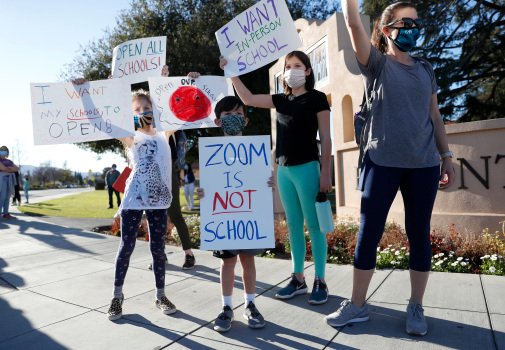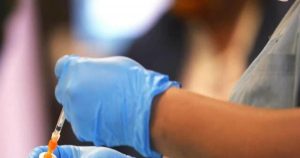SUNNYVALE, CALIFORNIA – FEBRUARY 23: Jill Borges, far right, a teacher at Cupertino High School, protests school closings in the Cupertino and Sunnyvale school districts with her three children, from left to right, Emry, 9, Cruz, 7, and Brooklyn, 13, in front of Fremont High School in Sunnyvale, Calif., on Tuesday, Feb. 23, 2021. (Nhat V. Meyer/Bay Area News Group)
 California parents frustrated over the sluggish pace of reopening public schools have long sensed the state was falling behind many others in getting kids back into classrooms, and now an analysis demonstrates with stunning clarity that the Golden State is running almost dead last.
California parents frustrated over the sluggish pace of reopening public schools have long sensed the state was falling behind many others in getting kids back into classrooms, and now an analysis demonstrates with stunning clarity that the Golden State is running almost dead last.
The analysis by Burbio, a community data service in New York that has been auditing 1,200 districts of various sizes across the country on their reopening status since last fall, shows California 49th among the 50 states in the proportion of students offered in-person instruction.
“California is way behind the rest of the country,” said Burbio co-founder Dennis Roche.
The analysis comes as the reopening debate intensifies in California amid mounting evidence that students can be brought back to classrooms safely, and that remote online “distance learning” has been a poor substitute for in-person learning.
It also comes as infection rates subside across the state after a deadly winter surge. Two Bay Area counties — San Mateo and Marin — advanced to the state’s second-most restrictive red tier, in which schools at all grade levels may open. And even those that remain in the most restrictive purple tier are now at infection rates where the state allows elementary schools to open.
During a COVID-19 relief bill signing ceremony Tuesday, Gov. Gavin Newsom fended off questions from journalists about progress toward reopening more schools. His administration remains locked in talks with fellow Democrats in the state legislature on competing plans to get students back in classrooms.
“We’ve been engaged for weeks now, months, candidly, on getting our schools safely reopened for in-person instruction, doing it in a very deliberative way,” Newsom said, adding he hopes to have more to say “in the next few days.”
Burbio’s team audits districts in all 50 states — representing more than 35,000 schools — and updates the data every 72 hours with changes, checking websites, Facebook pages, local news stories and other publicly available information to determine the learning mode currently in place in each.
They compile the information into an index of 0-100 for each state reflecting the proportion of students offered in-person instruction — 0 for online only, 50 for a hybrid of online and in-person instruction and 100 for traditional in-person instruction five days a week. A formula assigns a blended figure for those with varied instruction modes for different grades.
California’s index score of 11.1 was ahead of only Maryland’s 9.8, and comparable only to Oregon, at 12.8, and Washington, at 19.2. Among other large, populous coastal states with large cities and diverse populations and economies, the index was 90.8 for Texas, 99.9 for Florida, 49.4 for Pennsylvania, 49 for New York and 37.6 for Illinois.
Asked specifically why California trails the rest of the country in reopening, Newsom, who has refused to mandate reopening in favor of a collaborative approach, offered that the state is just emerging from its deadly winter surge and is more populous and complex than others.
“This is unlike any other school system in the United States,” Newsom said, rattling off statistics about California’s more than 6 million public school students, 58 counties, 470 cities and more than 1,000 school districts. “A month ago yesterday, we had just shy of 800 deaths reported — it was the highest single day in the state’s history since the beginning of this pandemic.”
Kate Gude of Los Gatos, a mother of four whose younger sons just returned to hybrid instruction earlier this month after a lengthy campaign by parents to get schools open, remains frustrated that her daughter’s high school remains in virtual mode with little sign it will reopen soon. She and other parents plan to rally outside the school Friday.
“They’ve had 10 months to prepare,” Gude said. “All these other states like Florida and others, they’re back.”
Roche, whose company began as a community events information service, said while 62% of districts nationally were doing virtual school by Labor Day last year, that figure fell to 37% by November. That closely tracks with what the U.S. Centers for Disease Control and Prevention reported in a study last month. And while many schools resumed online instruction as the winter case surge swept the country, it was easier for them to reopen this year, he said.
Roche said that governors and other state officials were key to getting schools to reopen.
“States like New York, (and) Ohio in the Northeast that got students in the classroom at much higher rates than California, the governors in the fall were pretty hands on,” Roche said. “Schools were not going to reopen without heavy involvement from the state level. These always-virtual states, you didn’t see those governors doing it in the fall. They all started doing it early in the new year, but at that point it was like, OK, you’re playing catch-up.”
Megan Bacigalupi, an Oakland parent with Open Schools CA, sees no excuse for California to be so far behind.
“It is unbelievable,” she said, “that despite all the evidence showing that school is safe for students and teachers with a few safety protocols, and hundreds of public health officials and physicians weighing in on the need to return children to classrooms for their mental and physical health, California finds itself almost last in the nation.”



















